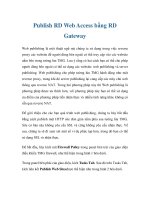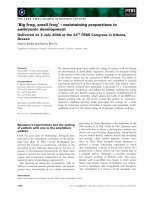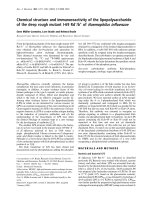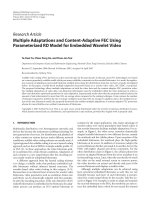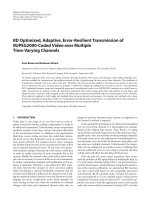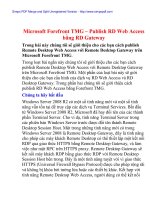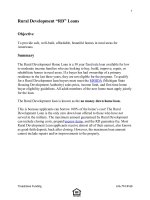Rd connections7
Bạn đang xem bản rút gọn của tài liệu. Xem và tải ngay bản đầy đủ của tài liệu tại đây (72.15 KB, 6 trang )
No. 7 • October 2008
Standard Setting: What Is It? Why Is It Important?
By Isaac I. Bejar
S
tandard setting is a critical part of
educational, licensing, and certification
testing. But outside of the cadre of
practitioners, this aspect of test development is
not well understood.
In tests used for certification and licensing
purposes, test takers are typically classified into
two categories: those who “pass”—that is, those
who score at or above the cutscore—and those
who “fail.”
These types of tests, therefore, require a single
cutscore. In tests of educational progress, such
Standard setting is the methodology used to
as those required under the No Child Left
define levels of achievement or proficiency and
Behind Act (NCLB), students are typically
the cutscores corresponding to those levels. A
classified into one of three or four achievement
cutscore is simply the score that serves to
levels, such as below basic, basic, proficient,
classify the students whose
and advanced (United States
score is below the cutscore
Congress, 2001). As a result,
Unless the cutscores are
into one level and the students
with four achievement levels,
whose score is at or above the
three cutscores need to be
appropriately set, the
cutscore into the next and
determined. 1
results
of
the
assessment
higher level.
In a K-12 context, decisions
could come into question.
Clearly, unless the cutscores
based on cutscores affect not
are appropriately set, the
only individual students, but
results of the assessment could come into
also the educational system.
question. For that reason, standard setting is a
In the latter case, group test results are
critical component of the test development
summarized
at the school, district, or state level
process.
to determine the proportion of students in each
This brief article does not address the
proficiency category. As part of NCLB
technicalities of the process, for which readers
legislation, for example, a school’s progress
can consult several references (Cizek & Bunch,
toward educational goals is expressed as the
2007; Hambleton & Pitoniak, 2006; Zieky,
proportion of students classified as proficient.
Perie, & Livingston, 2008). Instead, this article
So, how do we know if the cutscores for a
illustrates the importance of standard setting
given
assessment are set appropriately? The
with reference to accountability testing in K-12
and suggests that some of the questions that
have emerged concerning standard setting in that
1
NCLB is an example of standards-based reform. It differs
context can be addressed by considering
significantly from previous attempts at educational reform
characterized by “minimum competency.” According to Linn and
standard setting as an integral aspect of the test
Gronlund (2000) standards-based reform is characterized by the
development process, which has not been
adoption of ambitious educational goals; the use of forms of
assessment that emphasize extended responses, rather than only
standard practice in the past.
multiple-choice testing; making schools accountable for student
achievement; and, finally, including all students in the assessment.
www.ets.org
R&D Connections • No. 7 • October 2008
“right” cutscores should be both consistent with
the intended educational policy and
psychometrically sound.
The Standards for Educational and
Psychological Testing (American Educational
Research Association, American Psychological
Association, & American Council on
Measurement in Education, 1999) suggest several
soundness criteria, such as: “When proposed score
interpretations involve one or more cutscores, the
rationale and procedures used for establishing
cutscores should be clearly documented” (p. 59).
The accompanying comment further states that
“Adequate precision in regions of score scales
where cut points are established is prerequisite to
reliable classification of examinees into
categories.” (p. 59).
Differing State Policies
A further criterion in judging the meaning of
the different classifications, especially the
designation of proficient, involves an audit or
comparison with an external test (Koretz, 2006).
Two recent reports (Braun & Qian, 2007;
Cronin, Dahlin, Adkins, & Kingsbury, 2007)
took that approach by examining proficiency
levels across states against a national
benchmark. Both studies found that states
differed markedly in the proportion of students
designated as proficient.
Is one state’s educational system really that
much better than the other? It is difficult to say
by simply looking at the proportions of students
classified as proficient because each state is free
to design its own test and arrive at its own
definition of proficient through its own standardsetting process.
However, by comparing the results of each
state against a common, related, nationwide
assessment, it is possible to judge whether the
variability in states’ proportions of proficient
students is due to some states having better or
worse educational systems rather than being due
to the states inadvertently applying different
standards.
The study by Braun and Qian (2007) used the
National Assessment of Educational Progress
(NAEP 2 ) as the common yardstick for
comparing states’ proportions of students
classified into the different levels of reading and
mathematics proficiency against the NAEP
results for each state.
NAEP covers reading and mathematics, just as
all states do with their NCLB tests, but NAEP
has its own definition of proficiency levels and
its own approach to assessing reading and
mathematics, which differs from each state’s
own approach. For example, NAEP includes a
significant portion of items requiring constructed
responses—that is, test questions that require
test takers to supply their own answers, such as
essays or fill-in-the-blank answers, rather than
choosing from standard multiple-choice options.
Nevertheless, NAEP provides as close as we
can get to a common yardstick by virtue of the
fact that a representative sample of students
from each state participates in the NAEP
assessment.
The conclusion in the Braun and Qian (2007)
and Cronin et al. (2007) reports was that the
differences in the levels of achievement across
states seemed to be a function of each state’s
definition of proficiency—that is, the specific
cutscores they each used to define achievement
levels. The differences in levels of achievement
were not necessarily due to variability in the
quality of educational systems from state to
state.
In short, standard setting matters: It is not
simply a methodological procedure but rather an
opportunity to incorporate educational policy
into a state’s assessment system. Ideally, the
standard-setting process elicits educational
policy and incorporates it into the test
development process to ensure that the cutscores
that a test eventually produces not only reflect a
state’s policy but also are well-supported
psychometrically.
2
2
/>
Copyright © 2008 by Educational Testing Service. All rights reserved. ETS, the ETS logo and LISTENING. LEARNING. LEADING. are registered trademarks of Educational Testing Service (ETS)
in the United States of America and other countries throughout the world.
www.ets.org
R&D Connections • No. 7 • October 2008
Cutscores that do not represent intended
policy or do not yield reliable classifications of
students can have significant repercussions for
students and their families; fallible student-level
classifications can provide an inaccurate sense
of an educational system’s quality and the
progress it is making towards educating its
students.
(Bejar, Braun, & Tannenbaum, 2007). In fact,
Cizek and Bunch (2007, p. 247) proposed that
“standard setting be made an integral part of
planning for test development.”
The integration of standard setting into the test
development process becomes more crucial in
light of NCLB. 3 As part of NCLB legislation,
schools test adjacent grades every year. Because
the legislation calls for all students to reach the
Setting Standards
level of proficient by 2014, inferences about the
As mentioned earlier, the standard setting
proportion of students in different achievement
process has been well documented in several
categories in adjacent grades, or in the same
sources (Cizek & Bunch,
grade in subsequent years,
2007; Hambleton &
are inevitable because they
We cannot expect a test
Pitoniak, 2006; Zieky et al.,
are prima facie evidence
that does not cover the
2008). In this section, we
about the progress, or lack
emphasize the relationship
of progress, the educational
appropriate content or
of the standard setting
system is making towards
is not at the appropriate
process to test
the 2014 goal. More likely
development.
level of difficulty to lead to
than not, there will be
variability in the rates of
While setting standards
appropriate decisions—
proficiency in adjacent
appropriately is critical to
regardless
of
how
the
grades.
making sound student- and
process of setting cutscores
policy-level decisions, it is
For example, one
equally important that the
explanation for the
is
carried
out.
content of the test and its
variability in observed
difficulty level be
achievement levels across
appropriate for the
grades is that the standards
decisions to be made based on the test results.
across grades are not comparable. The cutscores
We cannot expect a test that does not cover the
that define a proficient student in two adjacent
appropriate content or is not at the appropriate
grades could, inadvertently, not be equally
level of difficulty to lead to appropriate
demanding.
decisions—regardless of how the process of
This can occur if the standard-setting process
setting cutscores is carried out.
for each grade is done in isolation without taking
Producing a test that targets content and
the opportunity to align the results across grades
difficulty toward the decisions to be made
(see Perie, 2006, for an approach to the
requires that item writers have a strong working
problem.) Similarly, failure to make the scores
understanding of those decisions. When
themselves comparable across years could
developers design a test in this fashion, it is
generate variability in the proportion of students
more likely that the cutscores will lead to
classified as proficient (Fitzpatrick, 2008).
meaningful and psychometrically sound
categorizations of students.
This means, however, that standard setting
must be done in concert with the test
development process and not be treated as a last
or separate step independent of the process
www.ets.org
3
In light of the upcoming national elections in the United States, it
will be necessary to monitor how federal educational policy will
evolve, but there is reason to believe standard setting will continue
to be part of the American educational landscape (Ryan &
Shepard, 2008, p. xii).
Copyright © 2008 by Educational Testing Service. All rights reserved. ETS, the ETS logo and LISTENING. LEARNING. LEADING. are registered trademarks of Educational Testing Service (ETS)
in the United States of America and other countries throughout the world.
3
R&D Connections • No. 7 • October 2008
An alternative explanation for the variability
in the different rates of achievement across
grades is that higher proportions of students
classified as proficient do, in fact, accurately
reflect a better or improving quality of education
in some grades. To reach that conclusion, it is
necessary to rule out the first explanation.
However, compensating for incomparable
standards is a complex and unfamiliar process.
In contrast, the process of equating—making
scores from different forms comparable
(Holland & Dorans, 2006)—has a long history.
The process of compensating for differing
standards is unfamiliar because
psychometricians in the United States had not
dealt with the issue prior to NCLB legislation,
which introduced the testing of students in
adjacent grades. Since that time, the field of
educational measurement has recognized the
issue and proposed solutions (e.g., Lissitz &
Huyhn, 2003).
However, attempting to compensate for
incomparable standards after the fact—that is, as
a prior step to releasing results—risks the
possibility that satisfactory compensation may
not be feasible. For that reason, it would be
preferable to develop the assessments for
different grades with comparable standards
across grades as an explicit criterion from the
start to avoid the problem as much as possible.
The foregoing complexities have motivated
the formulation of alternative accountability
models, as has a general dissatisfaction with the
“status model” approach to accountability
promoted by NCLB (Linn, 2005). Under this
current accountability model, results at a single
point in time are the basis for decisions as to
whether a school is making adequate progress.
Several states have proposed alternative
“growth models” (U.S. Department of
Education, 2005). An analysis of the different
features is available (Dunn & Allen, 2008). If
growth models go forward, standard setting will
be equally relevant to decide what growth rate is
adequate (Betebenner, 2008). In short, standard
4
setting is likely to continue to play a critical role
in the future.
Conclusions
Standard setting should be seen as a critical
aspect of the test development process best
carried out in concert with all other aspects of
the development process. Far from being a
purely methodological process, standard setting
ideally involves policy makers, test developers
and measurement specialists early on to ensure
that the test results will be useful and defensible.
References
American Educational Research Association,
American Psychological Association, &
American Council on Measurement in
Education. (1999). Standards for
educational and psychological testing.
Washington, DC: American Psychological
Association.
Bejar, I. I., Braun, H., & Tannenbaum, R.
(2007). A prospective, predictive and
progressive approach to standard setting.
In R. W. Lissitz (Ed.), Assessing and
modeling cognitive development in
school: Intellectual growth and standard
setting (pp. 1-30). Maple Grove: MN: Jam
Press.
Betebenner, D. W. (2008). Toward a normative
understanding of student growth. In K. E.
Ryan & L. A. Shepard (Eds.), The future
of test-based educational accountability
(pp. 155-170). New York: Routledge.
Braun, H. I., & Qian, J. (2007). An enhanced
method for mapping state standards onto
the NAEP scale. In N. J. Dorans, M.
Pommerich & P. W. Holland (Eds.),
Linking and aligning scores and scales
(pp. 313-338). New York: Springer.
Copyright © 2008 by Educational Testing Service. All rights reserved. ETS, the ETS logo and LISTENING. LEARNING. LEADING. are registered trademarks of Educational Testing Service (ETS)
in the United States of America and other countries throughout the world.
www.ets.org
R&D Connections • No. 7 • October 2008
Cizek, G. J., & Bunch, M. B. (2007). Standard
setting: A guide to establishing and
evaluating performance standards on
tests. Thousand Oaks, CA: Sage.
Linn, R. L., & Gronlund, N. E. (2000).
Measurement and assessment in teaching
(8th ed.). Upper Saddle River, NJ:
Prentice-Hall.
Cronin, J., Dahlin, M., Adkins, D., &
Kingsbury, G. G. (2007). The proficiency
illusion. Retrieved September 20, 2008,
from the Thomas B. Fordham Institute
Web site: />The_Proficiency_Illusion.pdf
Lissitz, R. W., & Huynh, H. (2003). Vertical
equating for state assessments: Issues and
solutions in determining adequate yearly
progress and school accountability.
Practical Assessment, Research, &
Evaluation, 8. Retrieved September 20,
2008, from />getvn.asp?v=8&n=10
Dunn, J. L., & Allen, J. (2008, March). The
interaction of measurement, model, and
accountability: What are the NCLB
growth models measuring? Paper
presented at the annual meeting of the
National Council on Measurement in
Education, New York.
Fitzpatrick, A. R. (2008, March). The impact of
anchor test configuration on student
proficiency rates. Paper presented at the
annual meeting of the National Council on
Measurement in Education, New York.
Hambleton, R. K., & Pitoniak, M. (2006).
Setting performance standards. In R. L.
Brennan (Ed.), Educational measurement
(4th ed., pp. 433-470). Westport, CT:
Praeger.
Holland, P., & Dorans, N. (2006). Linking and
equating. In R. L. Brennan (Ed.),
Educational measurement (4th ed., pp.
187-220). Westport, CT: Praeger.
Koretz, D. (2006). Testing for accountability in
K-12. In R. Brennan (Ed.), Educational
measurement (4th ed., pp. 531-578).
Westport, CT: Praeger.
Linn, R. L. (2005). Conflicting demands of No
Child Left Behind and state systems:
Mixed messages about school
performance. Education Policy Analysis
Archives, 13.
Retrieved September 20, 2008, from
/>
www.ets.org
Perie, M. (2006). Convening an articulation
panel after a standard setting meeting: A
how-to guide. Retrieved September 20,
2008, from the Center for Assessment
Web site: />publications/ RecommendforArticulation_
MAP06.pdf
Ryan, K. E., & Shepard, L. A. (Eds.). (2008).
The future of test-based educational
accountability. New York: Routledge.
U.S. Department of Education. (2005). Secretary
Spellings announces growth model pilot
study [Press release]. Washington, DC:
Author. Retrieved September 20, 2008
from />pressreleases/2005/11/11182005.html
United States Congress. (2001). No Child Left
Behind Act of 2001: Conference report to
accompany H.R. 1, report 107-334.
Washington, DC: Government Printing
Office.
Zieky, M. J., Perie, M., & Livingston, S. (2008).
Cutscores: A manual for setting standards
of performance on educational and
occupational tests. Available from
/>
Copyright © 2008 by Educational Testing Service. All rights reserved. ETS, the ETS logo and LISTENING. LEARNING. LEADING. are registered trademarks of Educational Testing Service (ETS)
in the United States of America and other countries throughout the world.
5
R&D Connections • No. 7 • October 2008
Acknowledgements
I am grateful to Rick Tannenbaum, Mike
Zieky, and, especially, to Dan Eignor. Their
comments, I believe, have improved the article.
Of course, I’m solely responsible for any
remaining problems.
R&D Connections is published by
ETS Research & Development
Educational Testing Service
Rosedale Road, 19-T
Princeton, NJ 08541-0001
Send comments about this publication to the above address or via
the Web at:
/>Copyright © 2008 by Educational Testing Service. All rights reserved.
Educational Testing Service is an Affirmative Action/Equal
Opportunity Employer.
ETS, the ETS logo, and LISTENING. LEARNING. LEADING. are
registered trademarks of Educational Testing Service (ETS).
6
Copyright © 2008 by Educational Testing Service. All rights reserved. ETS, the ETS logo and LISTENING. LEARNING. LEADING. are registered trademarks of Educational Testing Service (ETS)
in the United States of America and other countries throughout the world.
www.ets.org



